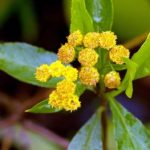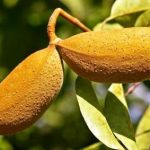TREE LIFE
JULY 1994
Is there a red dot on your Tree Life? It means that we have still not received your renewal subscription of $25 this will be your last Tree Life.
MASHONALAND CALENDAR
Saturday 2nd July. Botanic Garden Walk, at 10.45 for 11.00 a.m. The Herbarium gates are locked during the weekends but there will be a security guard at the public car park and this is where we will meet Tom.
Sunday 17th July. We have been to Mr. Hamish Charters’ farm Erene in the Marondera area before, just after the dam was built. Although the bush is dry, there is still a lot of interest, including several Rhamnus staddo. And of course there is a very good chance that the many tall Aloe excelsa will be flowering. Fagaropsis angolensis, a tree in the Rutaceae family occurs there but because it will probably be leafless we may not recognise it. There’s a challenge. We meet at 10 a.m.
New members may not know that our trips are all day outings and therefore picnic lunches should be brought along. We look forward to seeing our Marondera members again.
Saturday 23rd July. For Mark’s Botanic interest Walk this month we will be in the Greengrove Bird Sanctuary. To get to it, go east along Samara Machel Avenue past the new Cresta Hotel and Msasa and turn left into Wilson Drive. After 1 km turn right into St. Malo Avenue. Follow this round to the left and the sanctuary is on the right. Time – 3 p.m. as usual.
Wednesday 27th July. Mrs. Susan Carter-Holmes, a senior botanist from the Royal Botanic Gardens Kew, will give a lecture illustrated by colour slides on The Succulents of Kenya at Conquenar Hall (Riembarta), 250 Samora Machel Ave. East, at 6 p.m. A $5 entrance fee will be charged, and the proceedings will be over by 3 p.m. Susan has traveled widely in Africa and is a leading authority on Aloe, Euphorbia and other succulent plants. This will be an interesting and enjoyable lecture supported by excellent colour slides NOT to be missed.
Saturday 6th August. Botanic Garden Walk.
Saturday 10th – 14 Extra. Heroes/Defense Forces long weekend. We have been able to reserve accommodation at La Rochelle, Penhalonga for a smallish group. This will of course be booked on a first come first served basis, if you are interested phone Maureen Silva-Jones during office hours on Harare 739711 or at home on 25837, or Ian McCausland on Bulawayo 41946.
MATABELELAND CALENDAR
Sunday 3rd July. Aloe time in Nata. This will be a long all day trip – 250/300 km round trip. Meet at Girls’ College for a prompt 8.30 departure.
Sunday 7th August. To Chesa Forest, which will most probably be an all day trip as well.
SUNDAY 15 MAY 1994. CHIPPING ESTATE TEVIOTDALE
The site was typical highveld Miombo dominated by Msasa (Brachystegia) and Mnondo (Julbernardia). The rocks are dolerite and granite and the soil was fairly fertile dolerite soil.
Rocks and hilltops have always provided an interest to Tree Society outings. After the serious business of “trees”, there has often been a suggestion about taking a walk to view Bushman paintings.
At the hilltop there was a protective rock overhang and the rock wall beneath had a few delightful paintings. The interpretation of the paintings has always been open to conjecture but expert opinions have come from Tree Society members with interests in other disciplines. How fascinating it has been to muse, wonder and discuss.
There was a very graceful young female kudu in red colouring of the surrounding iron oxide in the rocks. Her ears were large, back slightly stooping and thin delicate legs capturing the ethos of a timid animal on stone.
Peter Garlake writes that 65% of animals painted in Zimbabwe are kudu and there is not a relationship between the frequency of occurrence of the species in nature or a dietary preference by the Bushmen. The observation is made on the frequency with which kudu bones are found along with debris of human occupation in the caves. There is some other principle regulating the choice of animals painted by the artists. The kudu cows often have young of their own or those of other animals.
Hunting scenes where kudu females are killed are recorded in paintings and descriptions by Elizabeth Goodall.
Why the kudu should be painted so frequently, and in particular the female, could be spiritual or symbolic or indicative of good pasture.
A little distance from the kudu was a magnificent macho male baboon with square shoulders, long mane and an arrogantly hooked tail. Somehow the unknown artist had captured the vitality, posture and characteristic movement of these animals simplistically on stone.
The Bushmen are no longer with us to decipher their delicate friezes and the tales of a bygone era.
Paintings are difficult to date because these are primary earth colours derived from rocks, ochre, iron oxides and haematite. As any artist knows these colours last, unlike pigments of plant origin. The colours were probably mixed with animal fat which will have decomposed and become oxidised and thus lost with time. And so there would be no carbon record to attempt to date the paintings.
On another part of the rock face where several figures with enlarged heads described by anthropologists as a spectre of religious power which could have emanated from the top of the spine. Trances were invoked by dancing.
It was suggested by somebody present that the trances could have been induced by smoking mbanje. However, there was no record of fires or smoking, although there are suggestions of the family hearth. The mbanje could have been taken as snuff.
The Bushmen did collect fruit, roots and berries. Hunting was the prerogative of the men and gathering of the woman. Roots were used in medicine as shown by a painting of a medicine man with edible roots at Madzanyara, Mutoko.
Plant material, and in particular; some species of fungi have hallucinatory properties.
Animals were identified with the Bushmen’s way of life. Grass, roots, bulbs and tubers are a small part of the subject matter. Trees were childishly painted to look like stippled lollipops or as individual leaves attached to branches. The tree roots were drawn at the base of the trunk. Most trees are difficult to identify. A tree painted with detailed perfection and quite characteristic has been identified as Kirkia acuminata in Muchekwa’s Cave, Murewa. The roots are swollen and act as water storage organs which are dug up by indigenous people and animals in the time of drought.
Perhaps as members of Tree Society we should try to identify some of the trees and plants. Next time a visit is made to Bushmen’s Point, Robert McIlwaine National Park at Lake Chivero take a careful look at those lollipop trees, a man is chopping down a tree!
Further up and around the hilltop amongst nettles were two people standing on their heads. Maybe it was an upside world for the gentle little hunter-gatherer, as they were squeezed out of existence by the cultivators of the plains and the early white settlers in Southern Africa, who destroyed them by shooting them like game in what can be only described as a process of planned genocide.
Are these lost people of many cultural and linguistic groups an omen of other losses like species of plant arid animals?
A fire break was in the process of being burnt on the hill nearby. There was evidence of recent fires in parts of the area. Many of the species of tree encountered were fire resistant.
Always at a Tree Society outing there is an expert. The fundi was Ann Bianchi, who proved to be an excellent mentor. Ann germinates “‘any tree seeds and has young trees for sale.
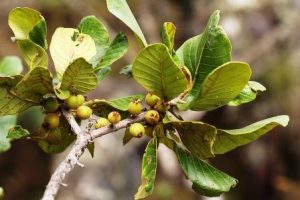
Uapaca kirkiana. Photo: Bart Wursten. Source: Flora of Zimbabwe
A protection against fire is a corky bark (Strychnos) and silica in the bark (Crossopteryx). Fire sensitive trees are found in areas of poor grass cover or on anthills or rocky places. Examples of these trees are the large leaf Uapaca kirkiana, Mukwa (Pterocarpus), and the pod mahogany, Afzelia quanzensis (Chamfuti). The observation of a large anthill surrounded by soil supporting poor grass growth was ecological proof. In the poor grassland next to the anthill were the tall trunks of Cussonia, upright with octopus-like branches without a leaf to be seen. The tree is deciduous. The bark was grey to brown, very corky and forming long deep ridges. One of the trees had been coppiced from below or not survived and had a new tree growing out from a truncheon. Anti-virus truncheon propagation is successful if the truncheons are not well watered. The same advice is given by Phillip Wood in Gardening in Zimbabwe.
The problem then was to identify the Cussonia without leaves, flowers or fruits. Easy, some dead leaves were found on the ground and these were digitate .i.e. compound with five or more leaflets. The tree was identified as the octopus cabbage tree, Cussonia arborea. The wood is poor and not of use in furniture. But in Malawi is made into xylophone keys and when struck give melodious sounds.
Another example of corky bark, fire resistance was Strychnos potatorum, the purple fruited grape Strychnos. The roots are ground and used as fish poison.
At the base of the anthill was Pappea capensis, Lobengula’s famous indaba tree. The tree was in flower with yellow-greenish catkin-like racemes. The flowers were growing too high to allow for identification as to whether a male or female tree. The leaves were simple, grouped near the end of the branches, green above, pale green below, and the margin were closely spine-toothed. The bark is pale grey to brownish and the wood hard and tough. The seed yields non-drying oil which is mildly purgative and is said to be a remedy for ringworm. It is also said to be a remedy for baldness. The oil can be used for soap making and lubrication. Farmers and maybe Lobengula’s Ndebele impis used it for oiling their spears or guns. Venereal diseases are treated with preparations of the bark. A useful muti tree.
One wonders what debates were heard under the Indaba tree between Lobengula and his indunas, especially when they discovered Lobengula had sold his birthright.
It is interesting to ponder the number and nature of historical wants witnessed by this tree. It is not sure if the Indaba tree is fire-resistant, but is propagated by truncheoning. The original Indaba tree is dead but side branches are reported to be growing from the roots.
The top of the anthill was crowned by a magnificent Acacia. The top of the tree was a mass of pods too thin to be Acacia sieberiana. The few remnants of leaves were too big for it to be Acacia nilotica. It identified as Acacia polyacantha. The white thorn or white trunk acacia, which was in disguise because the bark had been burnt and was no longer characteristic.
The seeds of many acacias germinate readily if first scarified. Acacia seeds are stimulated to germinate by fire or heat and respond to gentle cooking in a double boiler.
The little Acacia drepanolobium of the East African savannah have survived centuries of burning by the Maasai. The acacia was finally called Acacia formicarium because it was wrongly thought that the little ants living in the galls cause the galls. The ants have to make a hole in the galls and when the wind blows across the galls it makes a whistling sound like the little piping notes of the flute band. Hence the name the WHISTLING THORNS, who by legend pass on in whispers across the plains the stories of bygone days.
The exotic Hakea, introduced into the South Western Cape from Australia, germinate after fire in mad profusion and are a threat to the indigenous proteas of the Fynbos. Protea is found in grassland along with their relatives, Faurea, where fires occur. The Protea, Faurea and Hakea belong to the family Proteaceae. There was much debate as to whether the Protea was Protea angolensis or Protea gaguedi.Some quick aids to identifying the acacias
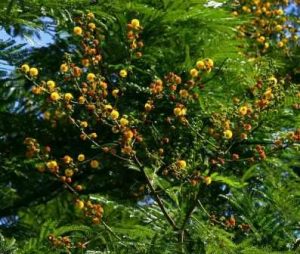
Acacia amythethophylla . Photo: Bart Wursten. Source: Flora of Zimbabwe
1) Acacia amythethophylla is the large-leafed acacia: Chitatsunga. It is easily recognised by the large leaves and the robust panicles of orange-yellow flower heads or pom-poms, which appear later than the other acacias in February and March.
The pods are found on top of the tree. They are black, blackish-purple when mature and hang on the dying tips of the branches. The growing tips die back and go black. The bark is rough and dark grey with longitudinal fissures. The spines are paired flattish and dark brown.
2) Acacia rehmanniana silky thorn: muunga. This is distinguished by a beautiful orange-reddish bark. In the younger trees, the rusty red velvet bark is arranged like many thin bangles. The bark is used for rope.
The young branchlets have yellowish-white hairs which turn greyish-white and look silky. The flowers are small, creamy white and beautifully scented. The leaves are small and fluffy covered with silky hairs. Pods are flat and straight. The spines are straight, long and white and are found on the trunks of younger trees.
Acacia rehmanniana can be confused with Acacia sieberiana, and distinguished by its rusty-red inner bark more numerous pinnae closely arranged to look bunched, and the pods are smaller and split.
Acacia abyssinica is much larger and flat-topped with yellow branchlets and seen on the way to Nyanga.
Acacia polyacantha, white thorn. A beautiful large tree with white flowers arranged in spikes up to 12 cm long.
The bark is pale yellowish-brown and flaky. When this bark peels the trunk can look almost white. The prickles are paired and hooked. The name polyacantha means many thorns. The pods are long, fiat and brown with no hairs. The roots have magical properties and will ward off snakes and crocodiles when crossing a river.
Acacia gerrardii or grey-haired acacia because the branchlets are covered with grey velvety hairs.
It is a small tree or shrub with a narrow pod which is thick and sickle-shaped and grey and hairy. The spines are short and formed from stipules.
Acacia karroo, sweet-thorn. The pods are very characteristic and these are sickle shaped, non-hairy and constricted between the seeds. The bark is reddish-brown to almost black. The spines are white and inflated. The flowers are prolific, golden bails, and sweetly scented, flowering several times and it is excellent for bees.
Sweet-thorn indicates sweet-veld. Leaves, pods and flowers can be eaten as a fodder. The bark is used for tanning and for making rope. The gum is used for confectionery. The large white thorns can be used as needles.
The fire was burning out and a flock of white-helmet shrikes had gone in search of insects disturbed by the fire.
-Mary Toet
BOTANIC GARDEN WALK: 4 JUNE 1994
Seventeen members of the Society met in the main car park in bright sunshine on a rather chilly Saturday morning. This was not our usual venue because the Herbarium gate is now locked at weekends. Tom’s subject was the genus Rhus.
Tom started by saying that the size and shape of the leaflets, whether they are toothed or not and whether hairy or not, taken together with the ecology of the plant were important factors in naming species of this somewhat slippery genus.
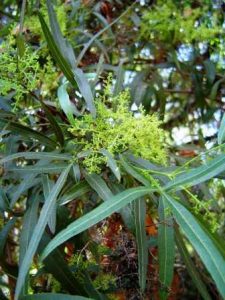
Rhus lancea. Photo: Bart Wursten. Source: Flora of Zimbabwe
Near the car park is the pond and by this were growing our first two species. Namely Rhus quartiniana (the River Rhus) and Rhus lancea (Willow Rhus). The former has hairy leaflets, especially when young, and entire leaflets. It occurs typically along streams and in river beds and is one of the first trees to appear in vleis.
Rhus lancea is very distinctive species with its long lance-shaped to linear leaflets, which lack hairs and have an entire margin. It also often occurs in riverine vegetation and in areas of high water-table.
A walk across the gardens took us to Rhus natalensis, which is now sunk into Rhus gueinzii but which in Tom’s view is better maintained as a separate entity. This has very shiny leaflets which are toothed in the upper half. This is a forest edge species occurring in high rainfall areas, for example in Eastern District outliers like Bikita, Wedza and Shurugwe.
Nearby was with entire leaflets. This is a rare species. Tom has only seen it once in a peculiar type of dry forest at Gwendingwe. At the base of the Eastern districts hill, we examined Rhus vulgaris with its hairy leaflets with occasional teeth.
Next was Rhus dentata in its purplish-bronzed autumn foliage. These leaflets are markedly toothed near to the apex only.
In the forest section was Rhus tomentosa which has leaflets which are very distinctively white-tomentose beneath. This is a small shrub occurring in the Nyanga area. 0n to Rhus chirindensis, which despite its name is actually very widespread in areas of high rainfall. Its leaves are shiny and entire and are drawn out into a somewhat elongate tip.
The specimen of Rhus pyroides had shed almost all its leaves. This species is often spiny and occurs very commonly in Matabeleland.
Rhus leptodictya was examined. This is a fairly common species of granite kopjies and anthills. It is somewhat like Rhus lancea in having relatively long and narrow leaflets but differs in being (usually) toothed.
Our final species was Rhus tenuinervis a small shrub of which was located after a search. It is a relatively well known species occurring quite frequently near Harare. Its leaflets are hairy and toothed.
As usual, our very great thanks to Tom for giving up his time for the Tree Society.
-MARK HYDE
MATABELELAND OUTING 5 MAY 1994
The turnout was smaller than last month, even though the sky was cloudless. The day commenced frosty, but waxed warm and stayed clear.
We drove on the Harare Road as far as the Fort Rixon turn-off, down which we proceeded to the Rixon Dam and Clubhouse. There we received a warm welcome from Linda Schur, who also kindly provided sweet naartjies for tea.
The Clubhouse has fallen temporarily into disuse, although it is hoped once again to revive its occupation. The dam is only 5% full, due to 5 successive bad rainy seasons. But I was informed that the hippos which were 6 on our previous visit are now 9.
Everybody had to patronize the Gents facilities, because the Ladies is occupied by Barn Owls. These delightful, captivating birds have made a terrible malodorous mess. Those who braved this were rewarded with a glimpse of an owl napping on the floor behind a refuse bin.
It is a pity, but they will have surely to be evicted. Knowing of owls’ persistence once they have selected a home, I hope this won’t be troublesome.
From the Rixon Club we went to Meikle’s Game Ranch at Engomeni where we were welcomed warmly by Mickie and Joan Parker. These kind folk directed us down the valley.
We entered miombo woodland on granite sandveld, dominated by Msasa (Brachystegia spiciformis) and Mnondo (Julbernardia globiflora) trees. What a glorious sight this place must be in the spring!
It was a strange Mashona-flavoured world. The kopjies were covered with desiccated Resurrection bushes, but the highlight for me was the forests of Euphorbia ingens. These ranged from seedlings to ancient giants. It is a mystery why this tree is conspicuously absent from the Matabeleland Tree Book.
Magnificent Mountain Acacias (Brachystegia glaucescens) surmounted granitic ridges. Here we were joined by Stanley Schur, and our gracious hosts took us on a bakkie ride through part of the Game Park, and we were able to wander through the impressive landscape. Autumn was apparent throughout, but an Elephantorrhiza tree thought it was spring and marked the occasion with a couple of flowers.
We returned to the very well appointed lodge for lunch. From here there is a splendid panoramic view as far as the Esigodini hills. The water hole situated down below was visited by Zebra (Burchell’s) warthog and a Tsessebe. An Egyptian goose kept guard on the sandbank.
After lunch we went to the Dhlo-Dhlo Ruins. The name is said to be derived from the isibongo or praise name of a local headman. At the turn of the century the place was known as the Mambo Ruins. The site is quite extensive, though in poorer shape than others nearby. Restoration is in progress and the remains of a hut on a platform have been protected by a roof and a fence. A new site Museum has been erected.
Only a few pieces of decorated walls remain. A Dovyalis zeyheri tree in fresh green leaves was prominent on the side of the steep approach. Acacia sieberiana and Canthium lactescens were two trees found here that had not been observed elsewhere, as was Celtis africana.
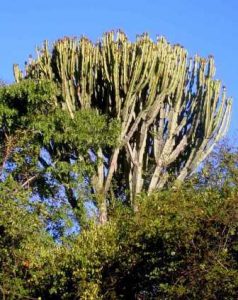
Euphorbia ingens. Photo: Bart Wursten. Source: Flora of Zimbabwe
Huge Euphorbia ingens amply illustrated the tree’s specific name and arose from the midst of some walls.
I was astounded to notice that the Sarcostemma viminale on one granite outcrop had stems as thick as my little finger and strong enough to resist my attempts to break a piece off.
We had afternoon tea down in the car park and then were able to set out for home.
We must thank our hosts most gratefully, and assure them that it was a delightful day.
The list of trees and other plants encountered is as follows:-
Acacia fleckii, Acacia galpinii, Acacia karroo, Acacia nilotica, Acacia rehmanniana, Acacia sieberiana (D). Albizia antunesiana, Albizia amara, Aloe excelsa, Azanza garckeana, Brachystegia glaucescens, Brachystegia spiciformis. Bridelia mollis, Burkea africana, Canthium lactescens (D), Carissa edulis (D), Celtis africana (D), Clerodendrum glabrum, Combretum molle (D), Combretum zeyheri. Commiphora schimperi, Croton gratissimus, Dichrostachys cinerea, Diospyros lycioides (D), Diplorhynchus condylocarpon, Dovyalis zeyheri (D), Elaeodendron matabelicum, Elephantorrhiza sp. Erythrina latissima (D), Euclea divinorum, Euclea natalensis (D), Euphorbia ingens, Ficus glumosa, Ficus ingens, Ficus sur, Ficus thonningii (D), Flacourtia indica, Gardenia ternifolia, Gardenia volkensii (D), Grewia bicolor, Grewia flavescens, Grewia monticola. Julbernardia globiflora, Kirkia acuminata, Lannea discolor (D), Maytenus senegalensis, Mundulea sericea, Mystroxylon aethiopicum (D), Ozoroa insignis, Pappea capensis, Parinari curatellifolia, Pavetta gardeniifolia (D), Pavetta schumanniana, Peltophorum africanum, Pouzolzia mixta. Pterocarpus angolensis, Pterocarpus rotundifolius (D), Rhus lancea, Rhus leptodictya (D), Rhus pyroides (D), Schrebera alata, Sclerocarya birrea (D), Sericanthe andongensis, Strychnos cocculoides, Strychnos spinosa, Tarenna neurophylla, Terminalia sericea, Ximenia caffra, Ziziphus mucronata (D), Cissus cornifolia, Maytenus heterophylla, Sarcostemma viminale (D), Loranthus sp., Viscum sp., Aloe chabaudii.
D = species found at Dhlo-Dhlo
THORA’S HERBAL HINTS
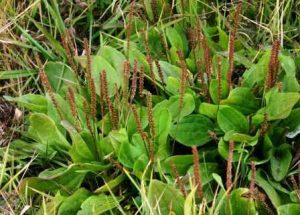
Plantago major. Photo: Bart Wursten. Source: Flora of Zimbabwe
Plantain – Plantago major, Plantago media, Plantago lanceolata, Plantago alpina, Plantago psyllium
There are numerous varieties of plantain, all having more or less the same properties and characteristics and therefore easily recognizable as all spring from a basal rosette directly attached to the rootstock, the leaves being ovate with strongly developed parallel longitudinal ribs.
Throughout the ages these plants, which seed themselves readily all over the garden, have been highly valued as an astringent, vulnerary and as a remedy for eye disorders.
There are repeated references to its healing powers in the plays of Shakespeare.
The leaves crushed and applied to wounds as an emergency dressing promote rapid healing – my book says that they heal a gaping wound with a seam of gold and oft have I proved this. The plantain which grows easily in all my garden beds is Plantago major – I think it came with the birdseed.
When Ken dropped the cat’s cage, from a height, onto his knee, it was one bloody mess and badly bruised. I quickly washed the area and then applied a large plantain leaf which I had also washed in hot water and crushed. Then I applied a crepe bandage.
Next morning, on removal, the whole area was clean – no sign of infection and the bruising and trapped blood had completely disappeared. I used three more dressings, night and morning and the wounds healed without scarring. Another time, when a stray cat sank its fangs deeply into the calf on my left leg, I again applied this emergency dressing. (The doctor said I must watch the cat and if it died within 24 hrs. to come in for anti-rabies injections). Again the healing was complete – no swelling, no infection and no scarring. Just recently on a trip to South Africa, while loading the car, Ken again gauged two nasty wounds in his calf and foot.
There was no time for further treatment, so plantain leaves were again applied. We stopped overnight in Pietersburg, staying with a friend who is an industrial chemist.
He was horrified at what I’d done and got ready bandages and antiseptics. Upon removing my dressing, he was absolutely amazed at the cleanliness of the wounds and is now keen to do some experiments with plantain. Yet in the days of yore it was the only dressing applied to sword wounds.
The fresh leaves of plantain are with dandelion leaves, eaten as a depurative salad by peasants in Europe. The fresh leaves, washed in boiled water and crushed are used as poultices on badly healing wounds and sores, varicose ulcers and scabbing. The crushed leaves rubbed on the skin soothe the irritation of insect bites or stings. Weasels, before attacking vipers, would roll in tufts of plantain to ensure total immunity.
A tea made from the leaves is recommended for bronchitis, whooping cough and tuberculosis. It is also taken for anaemia, enteritis, diarrhoea and dysentery.
A weak lotion is used as eyewash and in the treatment of inflammation of the eyelids.
The seeds (often used in poultry feed) act as a gentle purgative for constipation. The most active seeds are those of the plantain of the Midi, sold in chemist shops under the name of psyIlium.
So altogether these are amazing plants. I use the leaves in my garden brews for liquid manure and the old plants readily break down in the compost.
The Sickle Bush – Dichrostachys cinerea
This small shrub or acacia-like tree is also very invasive forming tough, thorny impenetrable thickets which are difficult to eradicate and yet it is one of nature’s wonderful medicinal trees used by tribes all over Africa.
The wood is hard and strong, termite and borer-proof, thus making excellent fencing posts as it is also able to withstand veld fires. The bark is tough and pliable and makes strong ropes and string.
A lotion made of the leaves and bark is a wound cleanser and healer. Dried powdered bark is sprinkled on to an open wound to promote healing. The lotion is also used to rinse out the mouth to ease toothache and a cloth soaked in it and bound round the head eases headache.
Dried powdered bark is also a direct application on skin eruptions, sores, blister and abscesses for both man and animal.
The dried root and leaf are smoked for chest ailments and tuberculosis, and to clear the head during a cold. A decoction of the root relieves pain and is often ministered to women in childbirth.
Snakebites, scorpion stings and insect irritations are treated with the leaf or bark, both being well chewed first and applied.
The inner bark is also used as a tourniquet.
The dried seedpods soaked in warm water make a soothing eyewash for red, tired eyes.
The shrub is well respected and is said to ward off evil if planted in the garden or near the house. It does make an attractive garden subject, can be pruned into shape, with its pretty dropping, pendulous flowers of mauve-pink and yellow and its interesting oddly contorted sickle-shaped pods.
-Thora Hartley
In the interests of conservation, the Aloe, Cactus and Succulent Society through the Cycad Branch are encouraging all owners of cycads to register them with the society.
This serves a dual purpose.
1) It is a criminal offence to buy or sell a local Cycad without a permit.
The Department of National Parks and Wild Life Management have also stated that possession of a Cycad, certainly an indigenous Cycad, requires the holder to have a permit. They intend to embark on an exercise to ensure that all cycads in private and public gardens are in fact recorded and registered. This they will do in conjunction with the Cycad Branch.
2) Cycads are fairly rare plants and one of the objects of the Branch is to make plants readily available to everyone through an intensive pollination campaign. So much male pollen is wasted in gardens and the Branch hopes to collect the pollen, place it in a pollen bank, and then make the pollen available for use on receptive female cones. This in order to obtain fertile seed which can be propagated resulting in many seedlings becoming available to all at reason¬able prices.
If you have Cycads in your garden please send an inventory with the following information to Cycad Branch, P 0 Box CY 300, Causeway.
Your name and address
Genus, Species, size/age (whether golf, cricket or soccer ball size).
If cone bearing – male or female or unknown.
Inventories will not be published or broadcast, their purpose is simply to secure the necessary records and to facilitate the creation of fertile seed.
ANDY MACNAUGHTAN CHAIRMAN


